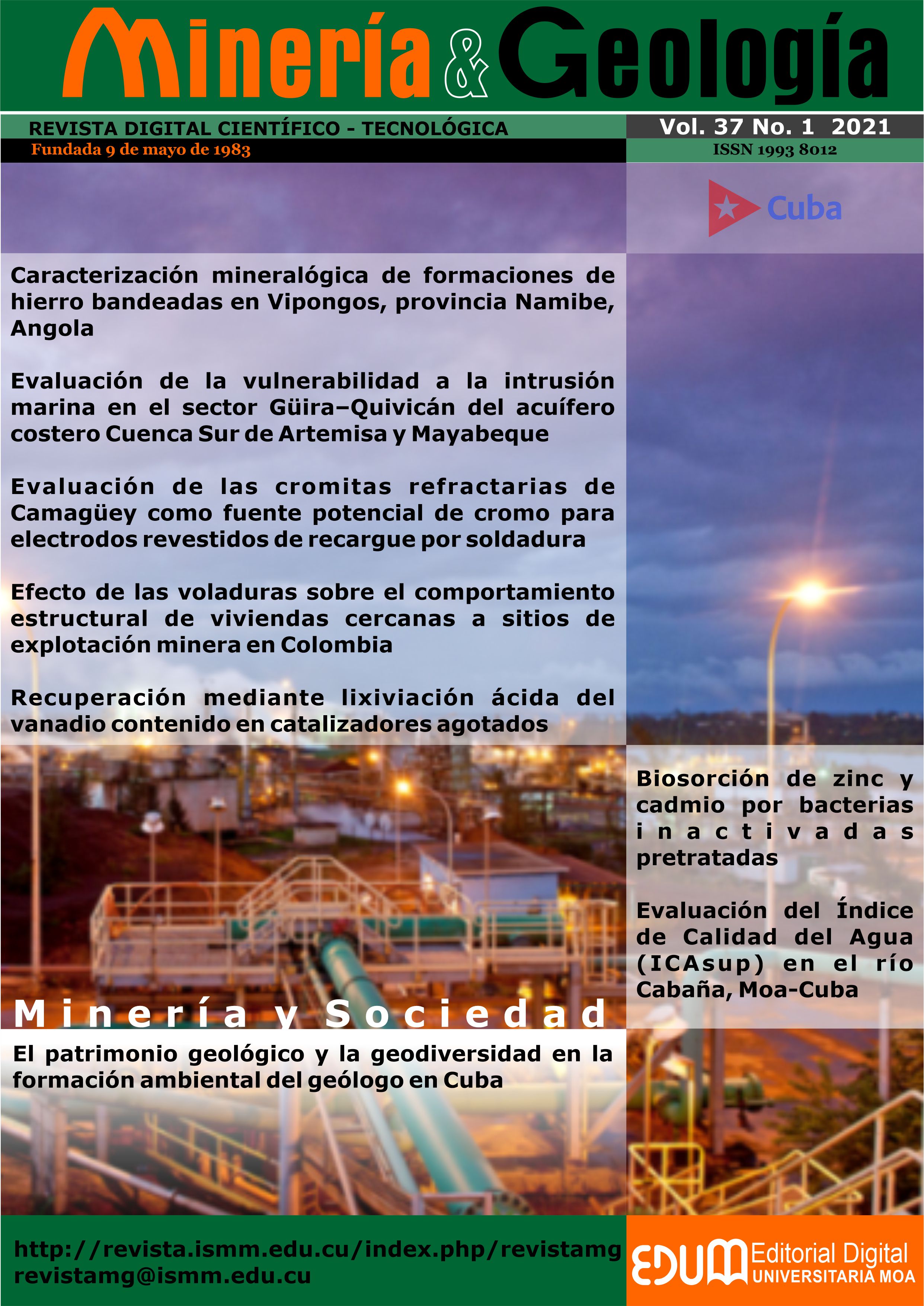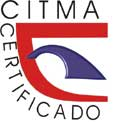Biosorción de zinc y cadmio por bacterias inactivadas pretratadas
Palabras clave:
metales pesados, biosorción, bacteria inactivada, solución bimetálica, cinc, cadmio, biomasa.Resumen
El empleo de microorganismos en procesos de biorremediación constituye una alternativa para disminuir la presencia de metales pesados en los diferentes ecosistemas, lo que es uno de los principales problemas ambientales del presente siglo. El objetivo del trabajo fue determinar la efectividad de biomasas bacterianas, inactivadas y pretratadas, en la biosorción de cinc (Zn (II)) y cadmio (Cd (II)) en soluciones mono y bimetálicas. Se aplicó calor seco para inactivar las biomasas de Bacillus cereus (AL-30), Acinetobacter sp. (AL-134) y Micrococcus sp. (AL-138) y posteriormente se trataron con KOH y HCl. En todos los casos se constató un incremento significativo de los valores de captura de ambos iones, superiores a 40 mg.g-1. Estos resultados permitieron conformar diferentes sistemas bacterianos mixtos que fueron eficientes en la biosorción, a partir de la solución monometálica, con porcentajes superiores al 91,4 % y al 87,6 %, para el Zn (II) y Cd (II), respectivamente. En la solución bimetálica se observó una mayor captura de cadmio con relación al cinc por los sistemas bacterianos mixtos. Se evidencian las potencialidades de las biomasas bacterianas inactivadas y con pretratamiento químico para ser utilizadas en procesos de depuración de efluentes con presencia de los metales.Descargas
Citas
Álvarez, A.; Sáez, J. M.; Costa, J. S.; Colin, V. L.; Fuentes, M. S.; Cuozzo, S. A.; Benimeli, C. S.; Polti, M. A. y Amoroso, M. J. 2017: Actinobacteria: Current research and perspectives for bioremediation of pesticides and heavy metals. Chemosphere, 166: 41-62.
Barange, M.; Srivasta, A.; Srivasta, J. y Palsania, J. 2014: Biosorption of heavy metals from wastewater by using microalgae. International Journal of Chemical and Physical Sciences, 3(6): 67-81.
Barros, M. J.; Macedo, G. R.; Duarte, M. M. L.; Silva, E. P. y Lobato, A. K. 2003: Biosorption of cadmium using the fungus Aspergillus niger. Brazilian Journal Chemical Engineering, 20(3): 1-17.
Bhutada, S. A. y Dahikar, S. B. 2017: Evaluation of removal of heavy metals by microorganisms isolated from industrial effluents. Journal of Applied and Advanced Research, 2(3): 156-160.
Choińska-Pulit, A.; Sobolczyk-Bednareka, J. y Łaba, W. 2018: Optimization of copper, lead and cadmium biosorption onto newly isolated bacterium using a Box-Behnken design. Ecotoxicology and Environmental Safety, 149: 275–283.
El-Naggar, E. N.; Hamouda, R. A.; Mousa, I. E.; Abdel-Hamid, M. S. y Rabei, N. H. 2018: Biosorption optimization, characterization, immobilization and application of Gelidiuma mansii biomass for complete Pb2+ removal from aqueous solutions. Scientific Reports, 8(1): 1-19.
Holan, Z. y Volesky, B. 1994: Biosorption of lead and nickel by biomass of marine algae. Biotechnology and Bioengineering, 43: 1001-1009.
Hu, W.; Dong, F.; Yang, G. y Peng, X. 2017: Synergistic interface behavior of strontium adsorption using mixed microorganisms. Environmental Science Pollution Research, 25(23): 22368-22377.
Jaafari, J. y Yaghmaeian, K. 2019: Optimization of heavy metal biosorption onto freshwater algae (Chlorella coloniales) using response surface methodology (RSM). Chemosphere, 217: 447-455.
Jiang, L.; Zhou, W.; Liu, D. y Liu, T. 2017: Biosorption isotherm study of Cd2+, Pb2+ and Zn2+biosorption onto marine bacterium Pseudoalteromonas sp. SCSE709-6 in multiple systems. Journal of Molecular Liquids, 247: 230-237.
Khan, T. A.; Mukhlif, A. A.; Khan, E. A. y Sharma, D. K. 2016: Isotherm and kinetics modeling of Pb (II) and Cd (II) adsorptive uptake from aqueous solution by chemically modified green algal biomass. Modeling Earth Systems Environment, 2: 117-131.
Mahmoud, M. E.; El Zokm, G. M.; Farag, A. E. M. y Abdelwahab, M. S. 2017: Assessment of heat-inactivated marine Aspergillus flavusas a novel biosorbent for removal of Cd (II), Hg (II), and Pb (II) from water. Environmental Sciences Pollution Research, 24(22): 18218-18228.
Mane, P. C.; Bhosle, A. B.; Vishwakarma, C. V. y Tupkar, L. G. 2010: Effect of pretreatment of algal biomass on bioadsorption of manganese. International Journal of Engineering Science and Technology, 2(12): 7550-7554.
Migahed, F.; Abdelrazak, A. y Fawzy, G. 2016: Batch and continuous removal of heavy metals from industrial effluents using microbial consortia. International Journal of Environmental Science and Technology, 14(6): 1169-1180.
Nagase, H.; Intorn, D.; Oda, A.; Nishimura, J.; Kajiwara, Y.; Parek, M. O.; Hirata, K. y Miyamoto, K. 2005: Improvement of selective removal of heavy metals in cyanobacteria by NaOH treatment. Journal of Bioscience and Bioengineering, 99(4): 372-377.
Okoli, C. P.; Diagboya, P. N.; Anigbogu, I. O.; Olu-Owolabi, B. I. y Adebowale, K. O. 2017: Competitive biosorption of Pb (II) and Cd (II) ions from aqueous solutions using chemically modified moss biomass (Barbulalam barenensis). Environmental Earth Sciences, 76(33): 1-10.
Pethkar, K.; Gaikaiwari, R. P. y Paknikar, K. M. 2001: Biosorptive removal of contaminating heavy metals from plant extracts of medicinal plants. Current Science, 80: 1216-1218.
Qiao, W.; Zhang, Y.; Xia, H.; Luo, Y.; Liu, S.; Wang, S. y Wang, W. 2019: Bioimmobilization of lead by Bacillus subtilis X3 biomass isolated from lead mine soil under promotion of multiple adsorption mechanisms. Royal Society Open Science, 6: 181701.
Rao, P. y Bhargavi, Ch. 2013: Studies of heavy metals using pretreated biomass of fungal species. International Journal of Chemistry and Chemical Engineering, 3: 171-180.
Ridha, M. J. M. 2015: Process optimization of biosorption Hg (II), Cu(II) and Ni(II) ions onto dead anaerobic biomass using a two-level full factorial design and response surface methodology, batch systems. Al-Nahrain University, College of Engineering Journal, 18(2): 328-342.
Saber, R. y Kinp, E. 2003: Investigation of complexation of immobilized metallothionein with Zn and Cd ions using piezoelectric crystals. Biosensor and Bioelectronics, 18: 1039-1046.
Suazo, E.; Morales, L.; Cristiani, Ma. Del C. y Cristiani, E. 2010: Efecto del pH sobre la biosorción de níquel (II) por Saccharomyces cerevisiae var. Ellipsoideus. Revista CENIC Ciencias Biológicas, 4: 1-12.
Sudhan, R. B. y Abrahan, T. E. 2002: Studies on enhancement of Cr (IV) biosorption by chemically modified biomass of Rhizopus nigricans. Water Research, 36: 1224-1236.
Uthra, K. y Kadirvelu, K. 2017: Biosorption of nickel using mixed cultures of Pseudomonas aeruginosa and Bacillus subtilis. Defense Life Science Journal, 2(4): 442-447.
Vieira, R. y Volesky, B. 2003: Biosorption: a solution to pollution? International Microbiology, 3(1): 17-24.
Volesky, B. 2007: Biosorption and me. Water Research, 41(18): 4017- 4029.
Zeraatkar, A. K.; Ahmadzadeh, H.; Talebia, F.; Moheimanin, R. y Mchenrym, P. 2016: Potential use of algae for heavy metal bioremediation, a critical review. Journal of Environmental Management, 30: 1-15.
Publicado
Cómo citar
Número
Sección
Los autores que publican en esta revista están de acuerdo con los siguientes términos:
- Licencia Creative Commons Atribución-NoComercial permite que el beneficiario de la licencia tenga el derecho de copiar, distribuir, exhibir y representar la obra y hacer obras derivadas para fines no comerciales siempre y cuando reconozca y cite la obra de la forma especificada por el autor o el licenciante.
- Los autores pueden establecer por separado acuerdos adicionales para la distribución no exclusiva de la versión de la obra publicada en la revista (por ejemplo, situarlo en un repositorio institucional o publicarlo en un libro), con un reconocimiento de su publicación inicial en esta revista.
- Se permite y se anima a los autores a difundir sus trabajos electrónicamente (por ejemplo, en repositorios institucionales o en su propio sitio web) antes y durante el proceso de envío, ya que puede dar lugar a intercambios productivos, así como a una citación más temprana y mayor de los trabajos publicados (Véase The Effect of Open Access) (en inglés).
- Lo anterior debe realizarse siempre sobre el artículo ya publicado por Minería y Geología.
La revista permite que los autores tengan los derechos de autor sin restricciones
La revista permite que los autores conserven los derechos de publicación sin restricciones










